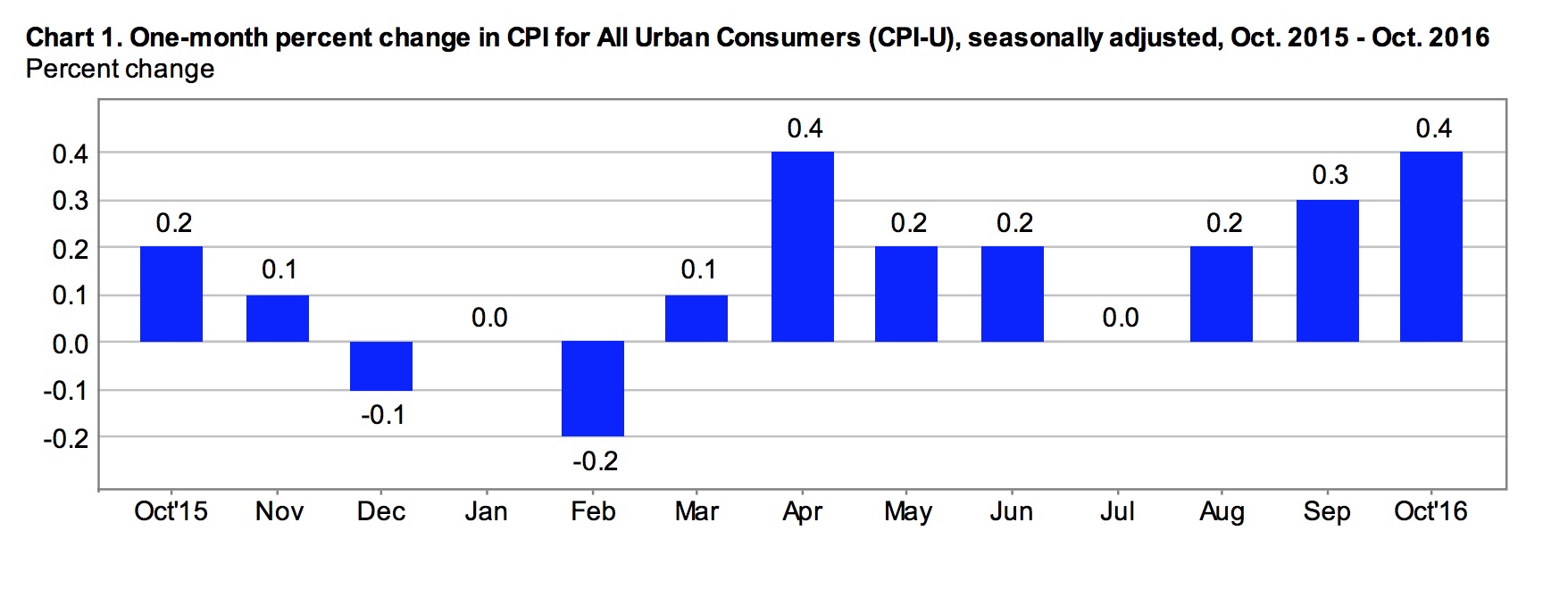Prices, measured by the consumer price index for all urban consumers (CPI-U), inched up 0.1% in October, after increasing 0.2% in September. However with seasonal adjustments, inflation accelerated to 0.4% in October from 0.3% in September due to a spike in energy prices. On an annual basis, the headline index climbed 1.6% in October, the highest annual rate in 2 years.
October’s CPI report, which the BLS released this morning, suggests that underlying economic strength has yet to put much pressure on consumer prices. Core inflation, up a seasonally adjusted 0.1% in October, was below analysts’ expectations. Year-over-year, core inflation has declined for the second consecutive month.
Today’s report is important as retail sales surpassed expectations this week and point to economic stabilization. Employment numbers are also strong, which makes the case for the Fed to begin tightening or raising rates to reign in accelerating economic growth. Inflation has been the missing piece in the Fed’s criteria for a rate hike and that has not changed today. However, October’s inflation numbers will likely not spook investors expecting to see interest rates moving higher.
October Prices
The energy index fell 0.5% in October prior to seasonal adjustments. Prices at the pump were 1.8% higher and fuel oil costs increased 5.9%. Offsetting this growth, the index for energy services declined significantly, down 2.8% due to a 3.7% drop in electricity service costs. With seasonal adjustments, gas prices were 7% higher in October and the energy index actually climbed 3.5% in October. Seasonally adjusted monthly inflation appears to be accelerating.
The price of food was up 0.1% in October but flat with seasonal adjustments. There was no change in the index for food at home. At the grocery store, a 0.8% decline in the index for meats, poultry, fish and eggs was balanced by higher prices for most other food items. The index for food away from home increased 0.1% in October.
The index for all items less food and energy gained 0.2 % in October. Within this core index, the index for shelter increased 0.3%, with rent prices up a monthly 0.5%. The medical services index was flat. The index for transportation services increased by 0.5%, including airfares climbing 1.3% and car insurance up 0.9% in October.
Annual Inflation
The CPI-U was up 1.6% year-over-year in October despite a 0.4% decline in the food index. To reflect consumer spending habits, food accounts for roughly 14% of the CPI-U. About 8% is allocated to food at home and the remainder measures the price of food away from home. Over the past year, the index for food at home has declined 2.3% and the index for food away from home has increased 2.4%. All six components of grocery store consumption posted lower prices year-over-year; the largest decline was in the price of meat, poultry, fish and eggs, down an annual 6.4%.
The energy index increased a modest 0.1% over the relevant year. Energy commodity prices fell 0.9%, including a 0.9% decline in gas prices. Energy service prices were up 1.3%. Commodities and services each account for roughly half of the energy index.
The index for all items less food and energy added 2.1% over the year ending in October. Shelter costs were reportedly up 3.5% with renters paying 3.8% more than a year earlier. The cost of medical care services also grew, up 4.1% as health insurance was 6.9% more expensive over the year ending in October. Prices for medical care commodities jumped 5%, driven by a 7% increase in the cost of prescription drugs.
The price of used cars and trucks declined 4.1% over the relevant year but the index for car and truck rentals grew 4%. Also notable, the cost of car insurance was 6.7% higher.
Market outlook
The FOMC met to discuss monetary policy on November 1-2 and decided to leave the overnight rate unchanged. Accomodative monetary policy was again deemed necessary to support improvements in the labor market and a return to the 2% inflation target. However, it is largely agreed at this point that the time to raise rates has come. Yellen has strongly indicated that this will happen in December. The pace of future rate hikes is less agreed upon.
Following some initial turmoil in the post-election markets, during which expectations for a rate hike in December temporarly dropped, markets have changed their tune. Inflation expectations have recently moved much higher as investors are betting on increased government spending to spur growth and drive future inflation. Markets have priced in a near 100% likelihood of a rate hike in December.





